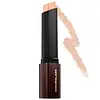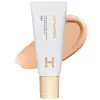Hourglass Cosmetics Hourglass Vanish Seamless Foundation Stick Versus Hourglass Cosmetics Veil Hydrating Skin Tint Foundation
What's inside
What's inside
 Key Ingredients
Key Ingredients

 Benefits
Benefits

 Concerns
Concerns

 Ingredients Side-by-side
Ingredients Side-by-side

Phenyl Trimethicone
Skin ConditioningC12-15 Alkyl Ethylhexanoate
EmollientCaprylic/Capric Triglyceride
MaskingEthylhexyl Methoxycinnamate
UV AbsorberEuphorbia Cerifera Wax
Ceresin
Emulsion StabilisingPolyethylene
AbrasivePentylene Glycol
Skin ConditioningMicrocrystalline Wax
Emulsion StabilisingPolyglyceryl-2 Triisostearate
EmulsifyingVp/Hexadecene Copolymer
Methyl Methacrylate Crosspolymer
1,2-Hexanediol
Skin ConditioningAluminum Hydroxide
EmollientBHT
AntioxidantCaprylyl Glycol
EmollientDimethicone
EmollientEthylhexylglycerin
Skin ConditioningIllicium Verum Fruit Extract
PerfumingIsostearyl Alcohol
EmollientLauryl Laurate
Skin ConditioningLauryl PEG/PPG-18/18 Methicone
Skin ConditioningMacadamia Seed Oil Polyglyceryl-6 Esters Behenate
EmollientMethicone
EmollientMica
Cosmetic ColorantPhenoxyethanol
PreservativePropanediol
SolventSilica
AbrasiveTalc
AbrasiveTriethoxycaprylylsilane
Iron Oxides
CI 77891
Cosmetic ColorantPhenyl Trimethicone, C12-15 Alkyl Ethylhexanoate, Caprylic/Capric Triglyceride, Ethylhexyl Methoxycinnamate, Euphorbia Cerifera Wax, Ceresin, Polyethylene, Pentylene Glycol, Microcrystalline Wax, Polyglyceryl-2 Triisostearate, Vp/Hexadecene Copolymer, Methyl Methacrylate Crosspolymer, 1,2-Hexanediol, Aluminum Hydroxide, BHT, Caprylyl Glycol, Dimethicone, Ethylhexylglycerin, Illicium Verum Fruit Extract, Isostearyl Alcohol, Lauryl Laurate, Lauryl PEG/PPG-18/18 Methicone, Macadamia Seed Oil Polyglyceryl-6 Esters Behenate, Methicone, Mica, Phenoxyethanol, Propanediol, Silica, Talc, Triethoxycaprylylsilane, Iron Oxides, CI 77891
Water
Skin ConditioningCaprylic/Capric Triglyceride
MaskingGlycerin
HumectantLimnanthes Alba Seed Oil
Skin ConditioningPropanediol
SolventSqualane
EmollientC9-12 Alkane
SolventErythritol
HumectantDicaprylyl Ether
EmollientPolyglyceryl-6 Polyricinoleate
EmulsifyingOctyldodecanol
EmollientDisteardimonium Hectorite
StabilisingDistarch Phosphate
AbsorbentPhenoxyethanol
PreservativePolyglyceryl-2 Isostearate
EmulsifyingMagnesium Sulfate
Zinc Stearate
Cosmetic ColorantSodium Benzoate
MaskingSodium Dehydroacetate
PreservativeButyrospermum Parkii Butter Extract
Skin ConditioningHydrogenated Lecithin
EmulsifyingCoco-Caprylate/Caprate
EmollientBenzoic Acid
MaskingPropylene Carbonate
SolventSodium Hyaluronate
HumectantDehydroacetic Acid
PreservativeLecithin
EmollientEthylhexylglycerin
Skin ConditioningTocopherol
AntioxidantAscorbyl Palmitate
AntioxidantNephelium Lappaceum Peel Extract
Skin ConditioningCitric Acid
BufferingStearic Acid
CleansingCI 77891
Cosmetic ColorantIron Oxides
Water, Caprylic/Capric Triglyceride, Glycerin, Limnanthes Alba Seed Oil, Propanediol, Squalane, C9-12 Alkane, Erythritol, Dicaprylyl Ether, Polyglyceryl-6 Polyricinoleate, Octyldodecanol, Disteardimonium Hectorite, Distarch Phosphate, Phenoxyethanol, Polyglyceryl-2 Isostearate, Magnesium Sulfate, Zinc Stearate, Sodium Benzoate, Sodium Dehydroacetate, Butyrospermum Parkii Butter Extract, Hydrogenated Lecithin, Coco-Caprylate/Caprate, Benzoic Acid, Propylene Carbonate, Sodium Hyaluronate, Dehydroacetic Acid, Lecithin, Ethylhexylglycerin, Tocopherol, Ascorbyl Palmitate, Nephelium Lappaceum Peel Extract, Citric Acid, Stearic Acid, CI 77891, Iron Oxides
 Reviews
Reviews

Ingredients Explained
These ingredients are found in both products.
Ingredients higher up in an ingredient list are typically present in a larger amount.
This ingredient is an emollient, solvent, and texture enhancer. It is considered a skin-softener by helping the skin prevent moisture loss.
It helps thicken a product's formula and makes it easier to spread by dissolving clumping compounds.
Caprylic Triglyceride is made by combining glycerin with coconut oil, forming a clear liquid.
While there is an assumption Caprylic Triglyceride can clog pores due to it being derived from coconut oil, there is no research supporting this.
Learn more about Caprylic/Capric TriglycerideCi 77891 is a white pigment from Titanium dioxide. It is naturally found in minerals such as rutile and ilmenite.
It's main function is to add a white color to cosmetics. It can also be mixed with other colors to create different shades.
Ci 77891 is commonly found in sunscreens due to its ability to block UV rays.
Learn more about CI 77891Ethylhexylglycerin (we can't pronounce this either) is commonly used as a preservative and skin softener. It is derived from glyceryl.
You might see Ethylhexylglycerin often paired with other preservatives such as phenoxyethanol. Ethylhexylglycerin has been found to increase the effectiveness of these other preservatives.
Phenoxyethanol is a preservative that has germicide, antimicrobial, and aromatic properties. Studies show that phenoxyethanol can prevent microbial growth. By itself, it has a scent that is similar to that of a rose.
It's often used in formulations along with Caprylyl Glycol to preserve the shelf life of products.
Propanediol is an all-star ingredient. It softens, hydrates, and smooths the skin.
It’s often used to:
Propanediol is not likely to cause sensitivity and considered safe to use. It is derived from corn or petroleum with a clear color and no scent.
Learn more about PropanediolThis ingredient is a combination of red, black, and yellow iron oxide pigments. This combination of colors is usually found in foundation, because it results in a "skin" color.